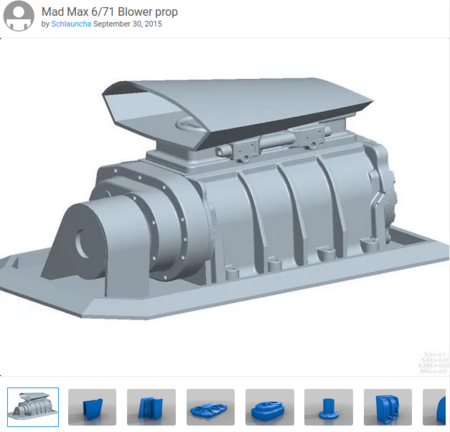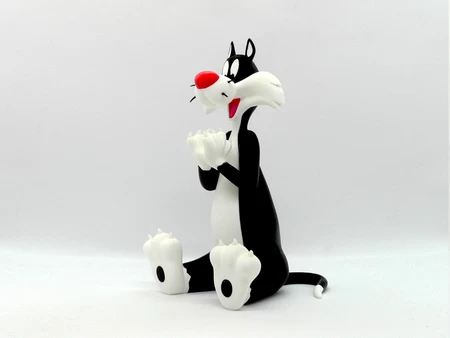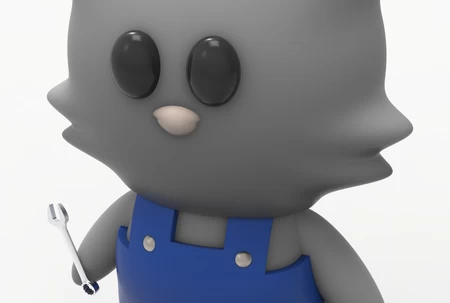公路赛跑者 3D打印
6192 视图 3 喜欢 0 下载 下载
公路赛跑者,又名哔哔,只会发出�...��志性的“哔哔”(有时会被误听成“咪咪”)的声音,偶尔还会发出“啪啪”的舌头声。他的宿敌威利狼利用极其复杂的装置和精心策划的计划试图抓住他,但每次都失败了。
无需支撑。一件包含内置支撑,一件包含内置支架。如果您想使用切片机支架,还提供不带内置支撑/支架的可选部件(请参阅下面的注释)。如果您有合适的灯丝颜色,则无需上漆。
组装好的模型高 155 毫米,长 280 毫米,与我之前发布的威利狼模型成比例。
分辨率:.2mm
填充:10%(请参阅可选的防尘特殊注意事项)
注意事项:**
请参阅以下注意事项,了解一...些有用的打印和组装说明。
...........................................................................................................
构建模型
颜色
黑色:(Paramount3D PLA - 黑色)
眼睛_黑色_右
眼睛_黑色_左
..
黄色:(Paramount3DPLA - 蛋黄黄色)
喙
喙_无_支撑(可选件)
脚_左
脚_右
..
深蓝色:(Parmount3d PLA - 军校蓝)
头部
翅膀_左
翅膀_右
..
白色:(Overture PLA - 白色)
眼睛_白色_左
眼睛_白色_右
..
浅蓝色:(3DSolutech PLA - 水蓝色)
身体
尾巴
尾巴_无_支架(可选件)
..
透明:(Bumat ABS - 透明)
(请参阅此灯丝选项的说明部件)
灰尘
................................................................................................................
打印和组装技巧
打印技巧
1 - 无需支撑。一件包含内置支撑、喙,一件包含内置支架、尾巴。如果您想使用切片机支架,还提供不带内置支撑/支架的可选部件。内置支架设计用于 .4mm 喷嘴(确保您没有将切片机设置为“厚桥”)和模型所呈现的尺寸。如果您大幅调整模型尺寸,请自行决定使用哪些部件。
2 - 有些部件可能需要边缘或筏,请自行决定。在设置我的打印件时,我更喜欢保守,以确保打印失败的可能性最小,特别是因为许多部件的底座在插入另一个部件时是隐藏的。
*我在以下部件上使用了帽檐:
(无需帽檐或筏子的部件)
3 - eye_black 部件是唯一非常小的部件。最好打印多份副本以防掉落。
4 - 从打印机床上取下部件时,将左/右部件放入单独的容器中以帮助组装过程是一个非常好的主意。有时左右部件之间的差异很小,但仍然值得跟踪它们并将它们组装到适当的位置。
5 - 我手头正好有透明的 ABS,所以我将它用于这个模型。我确实尝试过一种透明的灯丝,个人认为即使腿部更明显,其余的灰尘看起来也不那么好。此外,脚伸出得足够多,不透明的灯丝可能仍然适合这个模型。
6 - 为了让脚部透过灰尘看得更清楚,我使用了 10% 填充率的“闪电”填充图案。
..
组装技巧:
1 - 慢慢地将模型粘合在一起,享受这个过程。考虑一下将哪些部件作为组粘合在一起,然后将这些组粘合在一起。在组合组之前,让每组的胶水完全凝固。
2 - 我使用 3D Gloop 和 E6000 组装这个模型。我与 3D Gloop 没有任何关系,但尝试过为我的模型使用不同的胶水,发现这种胶水对我的模型来说是个不错的选择。每种胶水都有不同的优点/缺点,我发现 3D Gloop 比强力胶更容易使用(对我来说)。我也使用的 E6000 粘性胶水可以有更多时间定位部件,并且仍然是较小部件的最佳选择。3D Gloop 对我来说是中间地带,而且真的很棒。它留有足够的时间进行设置,因此可以正确定位零件,并且它干燥得足够快,可以固定不方便的零件而无需胶带。我使用的是管装的 PLA 版本。对于这两种胶水,使用较少的量通常比使用更多的胶水更好。
3 - 在将眼白放入头部/喙组件之前,应先将眼黑插入眼白中。
4 - 由于零件的形状,颈部与头部的连接并不像我希望的那么方便。我把所有头部零件粘在一起,把所有其余零件粘在一起。等两个部分的胶水完全凝固后,我使用 3dGloop 将头部连接到身体上。这种连接最好使用快干胶。
5 - Benoit 将脚粘在身体上,并旋转插入组合部件,以跟随灰尘中的开口。不需要胶水。
6 - 请参阅图片部分中的组装图以及上传的图片以组装模型。模型是用来粘贴的。
不要犹豫,提出问题,反馈对于制作更好的模型至关重要。
设计师
Steve Solomon3D 模型描述
公路赛跑者是华纳兄弟出品的《乐一通和梅里旋律》系列短片中的卡通人物。公路赛跑者,又名哔哔,只会发出�...��志性的“哔哔”(有时会被误听成“咪咪”)的声音,偶尔还会发出“啪啪”的舌头声。他的宿敌威利狼利用极其复杂的装置和精心策划的计划试图抓住他,但每次都失败了。
无需支撑。一件包含内置支撑,一件包含内置支架。如果您想使用切片机支架,还提供不带内置支撑/支架的可选部件(请参阅下面的注释)。如果您有合适的灯丝颜色,则无需上漆。
组装好的模型高 155 毫米,长 280 毫米,与我之前发布的威利狼模型成比例。
3D模型打印参数
支撑:否分辨率:.2mm
填充:10%(请参阅可选的防尘特殊注意事项)
注意事项:**
请参阅以下注意事项,了解一...些有用的打印和组装说明。
...........................................................................................................
构建模型
颜色
黑色:(Paramount3D PLA - 黑色)
眼睛_黑色_右
眼睛_黑色_左
..
黄色:(Paramount3DPLA - 蛋黄黄色)
喙
喙_无_支撑(可选件)
脚_左
脚_右
..
深蓝色:(Parmount3d PLA - 军校蓝)
头部
翅膀_左
翅膀_右
..
白色:(Overture PLA - 白色)
眼睛_白色_左
眼睛_白色_右
..
浅蓝色:(3DSolutech PLA - 水蓝色)
身体
尾巴
尾巴_无_支架(可选件)
..
透明:(Bumat ABS - 透明)
(请参阅此灯丝选项的说明部件)
灰尘
................................................................................................................
打印和组装技巧
打印技巧
1 - 无需支撑。一件包含内置支撑、喙,一件包含内置支架、尾巴。如果您想使用切片机支架,还提供不带内置支撑/支架的可选部件。内置支架设计用于 .4mm 喷嘴(确保您没有将切片机设置为“厚桥”)和模型所呈现的尺寸。如果您大幅调整模型尺寸,请自行决定使用哪些部件。
2 - 有些部件可能需要边缘或筏,请自行决定。在设置我的打印件时,我更喜欢保守,以确保打印失败的可能性最小,特别是因为许多部件的底座在插入另一个部件时是隐藏的。
*我在以下部件上使用了帽檐:
(无需帽檐或筏子的部件)
3 - eye_black 部件是唯一非常小的部件。最好打印多份副本以防掉落。
4 - 从打印机床上取下部件时,将左/右部件放入单独的容器中以帮助组装过程是一个非常好的主意。有时左右部件之间的差异很小,但仍然值得跟踪它们并将它们组装到适当的位置。
5 - 我手头正好有透明的 ABS,所以我将它用于这个模型。我确实尝试过一种透明的灯丝,个人认为即使腿部更明显,其余的灰尘看起来也不那么好。此外,脚伸出得足够多,不透明的灯丝可能仍然适合这个模型。
6 - 为了让脚部透过灰尘看得更清楚,我使用了 10% 填充率的“闪电”填充图案。
..
组装技巧:
1 - 慢慢地将模型粘合在一起,享受这个过程。考虑一下将哪些部件作为组粘合在一起,然后将这些组粘合在一起。在组合组之前,让每组的胶水完全凝固。
2 - 我使用 3D Gloop 和 E6000 组装这个模型。我与 3D Gloop 没有任何关系,但尝试过为我的模型使用不同的胶水,发现这种胶水对我的模型来说是个不错的选择。每种胶水都有不同的优点/缺点,我发现 3D Gloop 比强力胶更容易使用(对我来说)。我也使用的 E6000 粘性胶水可以有更多时间定位部件,并且仍然是较小部件的最佳选择。3D Gloop 对我来说是中间地带,而且真的很棒。它留有足够的时间进行设置,因此可以正确定位零件,并且它干燥得足够快,可以固定不方便的零件而无需胶带。我使用的是管装的 PLA 版本。对于这两种胶水,使用较少的量通常比使用更多的胶水更好。
3 - 在将眼白放入头部/喙组件之前,应先将眼黑插入眼白中。
4 - 由于零件的形状,颈部与头部的连接并不像我希望的那么方便。我把所有头部零件粘在一起,把所有其余零件粘在一起。等两个部分的胶水完全凝固后,我使用 3dGloop 将头部连接到身体上。这种连接最好使用快干胶。
5 - Benoit 将脚粘在身体上,并旋转插入组合部件,以跟随灰尘中的开口。不需要胶水。
6 - 请参阅图片部分中的组装图以及上传的图片以组装模型。模型是用来粘贴的。
不要犹豫,提出问题,反馈对于制作更好的模型至关重要。






![Schnappi 半身像 [德国卡通鳄鱼]](https://www.3dforprint.com/modelos/7291/schnappi-bust-german-cartoon-crocodile1_medium.png)
























